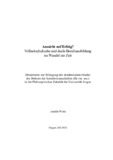Zitierlink:
http://dx.doi.org/10.25819/ubsi/10150Dateien zu dieser Ressource:
| Datei | Beschreibung | Größe | Format | |
|---|---|---|---|---|
| Dissertation_Jennifer_Weitz.pdf | 3.21 MB | Adobe PDF |  Öffnen/Anzeigen |
| Dokumentart: | Doctoral Thesis | Titel: | Aussicht auf Erfolg? | Titelzusatz: | Vollzeitschulische und duale Berufsausbildung im Wandel der Zeit | Sonstiger Titel: | Prospect of success? Full-time school-based and dual vocational training over time | AutorInn(en): | Weitz, Jennifer | Institut: | Fakultät I Philosophische Fakultät | Schlagwörter: | Berufsausbildung, Arbeitsmarkteintritt, Schulberufssystem, Duales System | DDC-Sachgruppe: | 370 Erziehung, Schul- und Bildungswesen | GHBS-Notation: | IDM IBS |
Erscheinungsjahr: | 2020 | Publikationsjahr: | 2022 | Zusammenfassung: | Eine gelingende Erstplatzierung am Arbeitsmarkt als wichtige Weichenstellung für das künftige Erwerbsleben ist ein immer wieder bestätigter Wissensbestand der Bildungssoziologie. Bei der Betrachtung des Übergangs von Ausbildung in den Arbeitsmarkt wird dabei sowohl im medialen und politischen Diskurs als auch im internationalen Vergleich das deutsche Berufsausbildungssystem häufig mit dem dualen Ausbildungssystem gleichgesetzt. Daneben existiert in Deutschland jedoch ein zweites vollqualifizierendes Berufsausbildungssystem: das Schulberufssystem. Die Ausbildung in diesem ist teilweise deutlich weniger standardisiert und institutionalisiert als diejenige des dualen Systems. Die Arbeit nimmt beide beruflich vollqualifizierenden Ausbildungssysteme gleichermaßen in den Blick und vergleicht die Arbeitsmarkterträge von Absolventen beider Systeme am Beginn des Erwerbslebens. Im Fokus der Analysen stehen die Dauer des Übergangs in die erste Beschäftigung, die horizontale und vertikale Ausbildungsadäquanz sowie die Stabilität der ersten Beschäftigung. Anhand von Daten des Nationalen Bildungspanels (NEPS) werden die Arbeitsmarkterträge der Ausbildungsabsolventen der Abschlussjahrgänge 1973 bis 2010 in Westdeutschland untersucht. Indikatoren für die berufsstrukturellen Merkmale werden mit Daten des Berufspanels für Westdeutschland (OccPan), des Mikrozensus und der Amtlichen Nachrichten der Bundesanstalt für Arbeit (Arbeitsstatistik) gebildet und den Individualdaten zugespielt. Mithilfe von Ereignisdatenanalysen und logistischen Regressionsmodellen wird der Einfluss der Ausbildungssysteme auf die Wahrscheinlichkeit untersucht, schnellstmöglich eine Erwerbstätigkeit zu beginnen sowie horizontal und vertikal adäquate Positionen und außerdem ein stabiles Beschäftigungsverhältnis zu erreichen. Es zeigt sich, dass das Schulberufssystem intern deutlich heterogener strukturiert ist als bisherige Untersuchungen nahelegen. Über die gesamte Arbeit hinweg wird zwischen Absolventen von Berufsfachschulen und von Schulen des Gesundheitswesens unterschieden, da letztere in vielerlei Hinsicht stärker mit denen des dualen Systems vergleichbar sind. Insgesamt zeigt sich, dass Absolventen des dualen Systems und der Schulen des Gesundheitswesens generell vorteilhaftere Übergänge haben als diejenigen der Berufsfachschulen. Die Arbeit leistet einen Beitrag zu unserem Verständnis dafür, wie berufliche Ausbildungssysteme individuelle Arbeitsmarktchancen strukturieren und zeigt langfristige Konsequenzen ungleicher Ausbildungsstrukturen auf. Successful initial placement in the labor market as an important setting of the course for future working life is a repeatedly confirmed body of knowledge in the sociology of education. When considering the transition from training to the labor market, the German vocational training system is often equated with the dual training system, both in media and political discourse and in international comparison. However, Germany also has a second fully qualifying vocational training system: the school-based vocational training system. The training in this system is in part much less standardized and institutionalized than that of the dual system. This paper looks at both vocational training systems and compares the labor market outcomes of graduates of both systems at the beginning of their working lives. The analyses focus on the duration of the transition to the first job, the horizontal and vertical training adequacy as well as the stability of the first job. Using data from the National Educational Panel Study (NEPS), we examine the labor market earnings of education graduates from the graduation years 1973 to 2010 in West Germany. Indicators for occupational characteristics are constructed using data from the Occupational Panel for West Germany (OccPan), the Microcensus, and the Official Notices of the Federal Labor Office (Labor Statistics) and are fed to the individual data. Event data analyses and logistic regression models are used to investigate the influence of the education systems on the probability of starting a job as soon as possible and achieving horizontally and vertically adequate positions and stable employment. It turns out that the school-vocational system is internally structured in a much more heterogeneous way than previous studies suggest. Throughout the paper, a distinction is made between graduates of vocational schools and of health care schools, as the latter are in many respects more comparable to those of the dual system. Overall, it appears that graduates of the dual system and of schools of public health generally have more advantageous transitions than those of vocational schools. The paper contributes to our understanding of how vocational training systems structure individual labor market opportunities and highlights long-term consequences of unequal training structures. |
DOI: | http://dx.doi.org/10.25819/ubsi/10150 | URN: | urn:nbn:de:hbz:467-22384 | URI: | https://dspace.ub.uni-siegen.de/handle/ubsi/2238 |
| Enthalten in den Sammlungen: | Hochschulschriften |
Diese Ressource ist urheberrechtlich geschützt. |
Seitenansichten
493
checked on 25.11.2024
Download(s)
460
checked on 25.11.2024
Google ScholarTM
Prüfe
Prüfe
Alle Ressourcen in diesem Repository sind urheberrechtlich geschützt, soweit nicht anderweitig angezeigt.

